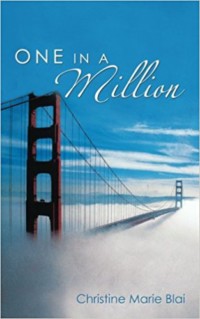Title: One In A Million
Author: Christine Marie Blai
Publisher: iUniverse
ISBN: 978-1-5320-0227-4
Pages: 192
Genre:
Romance
Reviewed By: Carol Davala
Pacific Book Review
Christine Marie Blai’s One In A Million is a compact novella which blends all the nuances of the romance genre and draws readers to the possibility chance encounters not only ignite passion, but can also provide an opportunity for lasting relationships. In the aftermath of an adulterous divorce, 24-year old Ohio college student, Mariette Stuart is getting her life back on track. During a two week vacation in San Francisco, courtesy of her mom, Mariette unintentionally finds herself in the midst of a recruitment drive for symphony-worker volunteers. Here she meets the handsome concert pianist, Christian Stanislaus. Though a Californian native, his Ukrainian and Polish background lends him a sophisticated Eastern European aire. Beyond a physical attraction, there appears an easy repartee and immediate connection between these two. While Mariette considers the enticement might be only a momentary diversion for the globe-trotting musician, Christian assures her otherwise. From pink roses and dinner invitations, to gallant gestures, there is romance in the making. Blai fills her story with classic themes of love and passion, fear and betrayal. As the pasts come to light and nasty rumors about Christian arise, Mariette must come to terms with major trust issues that threaten the couple’s future.
Blai’s choice details take us into the heart of San Francisco with its melting pot aesthetic of businessmen and prophets, skateboarders, panhandlers, and the Chinatown culture. In typical tourist fashion, the central characters share a cable car ride, dine at Fisherman’s Wharf, and visit the Japanese Tea Garden in Golden Gate Park. Even the crashing West Coast surf exudes its beauty and power and weaves its way into the story line presenting unexpected consequences. Like most romance stories, there is a pointed focus on passionate interludes. In this realm Blai perfectly levels the playing field, providing both Christian and Mariette opportunities to take charge. Such moments are detailed with a look, a movement, and a mounting intensity, like Christian’s musical performances, fulfilling the needs of each character. Interestingly, as the narrative progresses and tensions begin to surface, Blai lessens the detail of the sexual encounters and quietly segues from implied rendezvous with a mere hint of “after the intimacies.”
Chance meetings of central protagonists and whirlwind courtships with there “too good to be true” essence, can often lend a fairytale quality to modern romance novels. While Blai’s premise may be rooted in such traditions, the light she sheds on characters’ confrontations and conflict proves the creative ebb and flow of their amorous venture. The supporting cast of Mariette’s best friend Carlotta, and Christian’s concerned management team, all share an interest in keeping this romance on course. While the negative force of the story initially arrives in the plausible form of a vengeful music teacher intent on driving a wedge between Mariette and Christian, the subsequent appearances of this bitter nemesis seem a bit contrived.
Likewise, as dialogue in fictional romances can sometimes seem a bit cliché, particularly with sentiments such as “Believe in yourself and take the risks to get what you want in life,” clearly Blai uses such positive affirmations to help showcase the characters’ best intentions are at the heart of this tale. Infusing the narrative with phrases of German dialect brings an added layer of old-world charm and appeal.
For readers who enjoy the journey of newfound romance, tempered with the highs and lows of passion, artistic fervor, and life’s unexpected possibilities, Blai’s creative composition hits all the right notes.



Follow Us